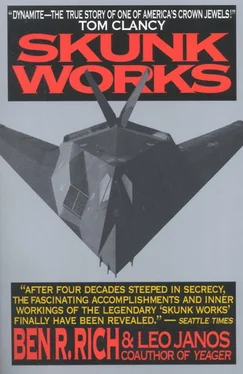During the 1980s an incredible $2 trillion was spent on military acquisitions alone, with new aircraft receiving the largest share of the defense budget, about 43 percent, followed in distant second place by missiles and electronics. The development costs of fighters have increased by a factor of 100 since the 1950s, and unit procurement costs have risen 11 percent every year since 1963! Small wonder, then, that there were only seven new airplanes introduced in the 1980s, compared to forty-nine in the 1950s. Only three new airplanes have been produced so far in this decade. Correspondingly, the aerospace industry has lost more than a quarter of its workforce since 1987.
New technology cannot be put on a shelf. It must be used. And the desperate need is to try to find ways to drastically reduce costs that would allow new generations of aircraft to evolve within the parameters of extremely modest defense expenditures. That will be the great challenge facing the Pentagon and the defense industry in the years to come.
I would like to share a few cost-saving ideas, but with the following caveat: in some ways I really do think that aerospace has gotten a bum rap from its critics. For example, General Motors spent $3.6 billion giving birth to the Saturn automobile, and it doesn’t even go supersonic. We spent $2.6 billion creating the stealth fighter and were able to keep costs down by incorporating the flight controls of the General Dynamics F-16 fighter and using the engine from the McDonnell Douglas F-18. We didn’t start from scratch but adapted off-the-shelf avionics developed by others. Avionics is the killer expense, costing about $7,000 a pound in a new airplane. A case in point is our own F-22 Advanced Tactical Fighter, which we designed at the Skunk Works in 1988, to replace the F-15, which has been the primary tactical fighter for the blue-suiters since 1972. In answer to the question, do we really need the F-22, comes another question: do we really want our combat pilots putting their lives on the line in a fighter now more than twenty-two years old?
The F-22 is a performing miracle. It can fly supersonic without afterburners, and using a revolutionary Thrust Vector Control System, can fly at extreme angles of attack while changing directions at high speeds, thereby outperforming any other airplane in the world—all this with the stealth invisibility achieved by the F-117A. To perform its incredible feats, the F-22’s avionics is as powerful as seven Cray computers! When we bid on this airplane we did so with the understanding that we would build seven hundred of them. That number would justify the enormous development costs that we shared with the government. Uncle Sam gave us $690 million and we put up a similar amount. The development phase was so expensive that we partnered with General Dynamics and Boeing. Northrop, our competitor, also put up $690 million in partnership with McDonnell Douglas. We won the competition, but all five companies involved in the F-22 contest have lost. We, the winners, will never make back our original investment because in the current budget crunch the government has cut back sharply on the number of F-22s it now plans to purchase. Currently, the Air Force has budgeted for four hundred new F-22s, but that number could decrease even further. The fewer the new airplanes produced, the more expensive the unit cost. The F-22 currently costs around $60 million each—the most expensive fighter ever. Meanwhile we and our partners are carrying huge production overheads in tooling and personnel. The sad truth is that our stockholders would have done better financially if they had invested that $690 million in CDs.
New advanced-technology airplanes are budget breakers. The B-2 bomber, at more than $2 billion a copy, proves that point. But we need stealthy long-range bombers like B-2s, which can fly anywhere in the world in twelve hours and drop a payload of forty conventional bombs. Still, unless we manage to get wildly inflated production costs down, aeronautics could well become an arcane art practiced by one or two manufacturers who somehow manage to survive. (Grumman, the Navy’s principal supplier of fighters for nearly sixty years, recently abandoned the sluggish fighter business entirely, while several other big manufacturers are also rumored to be planning to quit increasingly high-risk and unprofitable military aircraft production.)
So an urgent question to pose is how can an airplane as revolutionary and advanced as the F-22 be made for considerably less money? One way, which I have been promoting in vain for several years, would be to make it even more revolutionary than it already is. That is, much of the horrendously expensive avionics on board allows the F-22 to perform incredible aerodynamic maneuvers, from climbing straight up to pulling enormous g-loaded turns. But what if we invent onboard weapons systems that perform all the maneuvering while the airplane itself flies straight and level? In other words, missiles that could electronically lock onto a dogfighting target and swivel and turn at twelve gs while the airplane flies at only two gs. Such a reversal would drastically reduce the huge avionics costs.
Like true Skunk Workers, the aerospace industry as a whole must start thinking in new directions. Why build each new airplane with the care and precision of a Rolls-Royce? In the early 1970s, Kelly Johnson and I had dinner in Los Angeles with the great Soviet aerodynamicist Alexander Tupolev, designer of their backfire Bear bomber. “You Americans build airplanes like a Rolex watch,” he told us. “Knock it off the night table and it stops ticking. We build airplanes like a cheap alarm clock. But knock it off the table and still it wakes you up.” He was absolutely right. The Soviets, he explained, built brute-force machines that could withstand awful weather and primitive landing fields. Everything was ruthlessly sacrificed to cut costs, including pilot safety.
We don’t need to be ruthless to save costs, but why build the luxury model when the Chevy would do just as well? Build it right the first time, but don’t build it to last forever. Why must every aircraft be constructed to fly for twenty thousand hours and survive the stresses and strains of a thousand landings and takeoffs? Why not lower the endurance requirements for the majority of airframes? Wars are now planned to last ninety days because after that time ammunition reserves run out. In battle, most airplanes will be deployed for a few hundred hours at most. It would be cheaper to dispose of them once they’ve seen combat than to stockpile vast quantities of replacement parts and engines. We could make a small number of aircraft to last for years in training flights. But produce the majority—the ones destined for a relatively short spurt of combat flying—with less expensive materials. This same sort of Skunk Works’ cost-reduction thinking could extend to airplane tires arid other parts. Why, for example, must tires last for one thousand landings? If we mass-produced them at somewhat lower standards, we could throw away airplane tires after ten landings and still save money.
We cannot enjoy total product perfection and really don’t need it. The only areas where the final result must be 100 percent are safety, quality, and security. That final 10 percent striving toward maximum perfection costs 40 percent of the total expenditure on most projects.
General Electric’s jet engine plant at Evendale, Ohio, sells its engines to the commercial airlines for 20 percent less than to the Air Force. Price gouging? No. But the Air Force insists on having three hundred inspectors working the production line for its engines. The commercial airlines have no outside inspectors slowing down production and escalating costs. Instead, the airline industry relies entirely on GE’s engine warranty, a guarantee that the engine will function properly or GE will be required to pay a penalty as well as all costs for replacement, repairs, and time lost. Why can’t the Air Force operate with similar guarantees and save 20 to 30 percent on engine costs and eliminate three hundred unnecessary jobs to boot?
Читать дальше












